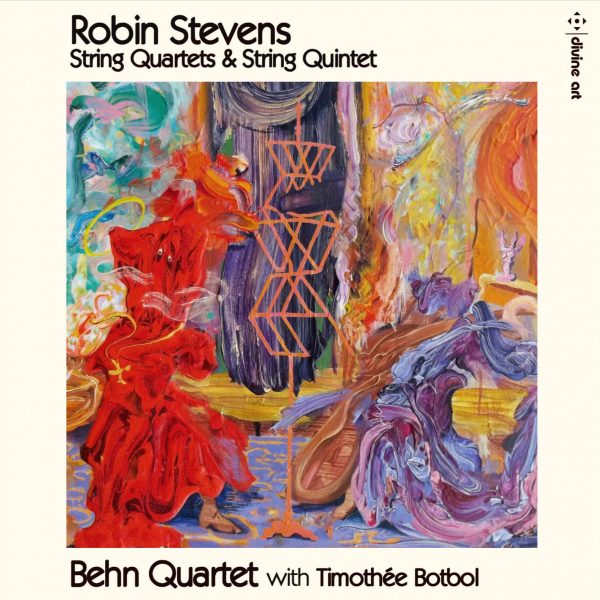Fanfare
There is an enormous stylistic range between the pieces on this disc. The String Quintet is an early work, written when the Welsh composer Robin Stevens (b. 1958) was in his early 20s. Adding an extra player to the standard string quartet, it is a so-called cello quintet like Schubert’s late Quintet in C rather than a viola quintet like Mozart’s. Stevens revised it in 2018 for this recording, but the work retains its fairly conservative language. Stevens comments that revisiting the score revealed many unconscious references to early 20th-century music, including near-quotes. It reminded him of the possibly apocryphal words of an American tourist who, “on seeing Hamlet for the first time remarked, ‘Gee, I didn’t realize it was so full of quotations!’”
In terms of his overall development, Stevens finds the fingerprints of his later style in the Quintet: “Beethovenian motivic development; rhapsodic, modal lyricism; bold, dramatic gestures; tangy harmonies; intricate counterpoint; and unashamedly direct, open-hearted expression.” Besides Beethoven I would add that Stevens must have known Schubert’s Quintet, if nothing else for the colors possible from an ensemble with two cellos. The third movement of his score, Adagio non troppo, is particularly lovely, with a central fugue that is very skillfully written. The second movement Scherzo and the finale incorporate some jazzy elements and a good deal of dramatic thrust. Any listener who is comfortable with the music of Bartók, Prokofiev, or Stravinsky is likely to find this quintet appealing.
From the beginning of String Quartet No. 1, composed in 2008, we are in a very different sound world. Stevens had suffered a debilitating illness that he does not name (an online bio refers to it as post-viral fatigue), and between 1991 and 2007 he was only able to write a few “experimental miniatures.” Regaining his full health in 2007, he began composing in what he calls a “contemporary classical idiom.” Some of the lyricism evident in the Quintet is still on display here, but it is heard in the context of a much denser style and a much more dissonant harmonic language. This work is in a single half-hour movement, and the overall impression left behind is one of severity, and relatively unrelieved severity at that.
The Second String Quartet, composed in 2011, is in three movements and an Epilogue but at 15 minutes is less than half the length of the First. Its title, “Three Portraits,” refers to personality characteristics that Stevens is depicting, not specific people. The three are “Impulsive One,” “God-Seeker,” and “Arguer.” There is a much greater variety of mood and color here than in the First Quartet. Stevens writes that we “could regard the three characters … as different members of the same family: distinctive individuals, yes, but with an overarching family resemblance, expressed in musical terms by subtle thematic bonds between the three portraits.”
I found this work more gratifying than the First Quartet. The character types are depicted clearly in the music with wit and affection. There is a playfulness to the “Impulsive One,” and quick mood changes abound. The “God-Seeker” is the movement with the strongest sense of melody. A lovely brief chorale is heard and then treated in variation form. Delicate, even ethereal, textures dominate. A very loud pizzicato chord takes us directly into the third movement, “Arguer.” Very strong dance-like rhythms interplay—the four instruments each appear to want to go in their own direction. A hushed ending leads into the brief Epilogue, a touching movement that brings peace and reconciliation to the fore.
The outstanding performances are by the Behn Quartet (an ensemble consisting of players from England, the Netherlands, Portugal, and New Zealand), which is in residence at the Royal Birmingham Conservatoire. They are clearly committed to the music; nothing here has the feeling of note-reading. They (and cellist Botbol in the Quintet) have absorbed Stevens’s style and believe in it. I can recommend this release to adventurous listeners interested in chamber music being composed today. For myself, I found much to enjoy in the Quintet and Second Quartet, but the austerity of the First Quartet was something to which I could not relate. Excellent notes from the composer comprise the accompanying booklet, and the recorded sound is very well balanced and clean.
@divineartrecordingsgroup
A First Inversion Company
Registered Office:
176-178 Pontefract Road, Cudworth, Barnsley S72 8BE
+44 1226 596703
Fort Worth, TX 76110
+1.682.233.4978
We noticed you're visiting from United States (US). We've updated our prices to United States (US) dollar for your shopping convenience. Use Pound sterling instead. Dismiss












